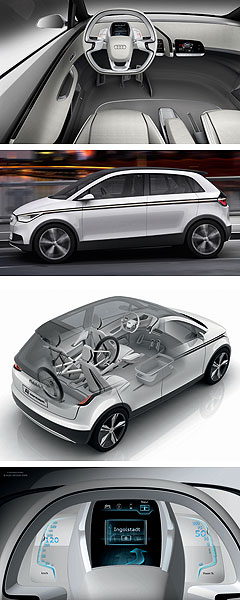New Audi A2 not before 2015
BY BYRON MATHIOUDAKIS | 20th Sep 2011

Still at the early development stage, with a platform strategy yet to be determined, it is likely that the production vehicle that bears the same name will look different by the time the first car reaches dealership forecourts.
Part of the delay centres around the disparate number of propulsion systems earmarked for the A2.
These are thought to include regular fossil-fuelled engines (petrol/diesel), pure electric power, plug-in hybrid range-extender and hydrogen fuel cell varieties.
Whether all drive systems find their way in to the A2 has yet to be determined, although Audi is actively investigating all these and more for all of its future vehicle programs.
“It is not black or white – the idea of the A2 is that it will be very colourful,” said Audi’s head of electro-mobility, Franciscus van Meel, at Frankfurt.
“There will be a lot of different technologies standing next to each other according to the way the car is used and the type of environment that you are in.
“There is a difference whether you are in New York or in Mumbai or in the countryside – there are different requirements for mobility,” he added.
The first purely electric Audi – the A8 e-tron – is due in 2013 at the earliest.

Since then the second-generation TT (2006) and R8 sportscar have employed a high degree of aluminium.
For the A2 new construction methods bonding and/or riveting aluminium with carbon-fibre and other ultra-strong and light fibrous materials are under investigation to drastically cut weight. Dubbed ‘Ultra’, Audi is also seeking to reduce their cost and complexity for mass production.
Developing pioneering joining technologies for aluminium and fibre materials is another major goal for the company’s scientists and engineers.
The next-generation R8 due in 2014 will be the first to boast the latest development of the Ultra thinking and will be 100kg lighter than the current model as a result, says Michael Dick, member of the board of management for technical development.
The A2 Concept has a weight objective of 1250kg, “which is a very demanding target,” he said.
Meanwhile, the development of ‘Connectivity’ within the A2 is another process that is requiring time to perfect, as this involves the implementation of outside infrastructure and includes governmental support on a variety of levels and hierarchies.
While some European urban centres are more advanced than others, the situation in far-flung outposts like Australia has yet to be determined, says Audi.
“We’re currently discussing the infrastructure side and what the communication will be like,” Mr van Meel said.
“Infrastructure is about talking to each other, about charging times and charging prices, and the communication is still ongoing.
“From the customer’s point of view it is about plugging in during all weather conditions, but in the future it will also be wireless charging, where you just park you car on a hotspot and your car will be charged.
“The standardization program for Europe with a two-plug electric socket for all of our cars (and beyond Audi vehicles to include all manufacturers) is the first step, and from the customer’s point of view the next step will be to go away from the plug to wireless charging.
“We cannot do it on our own. We can make it happen technically but the infrastructure has to be there. And it is one of the main challenges in electric mobility anyway.”